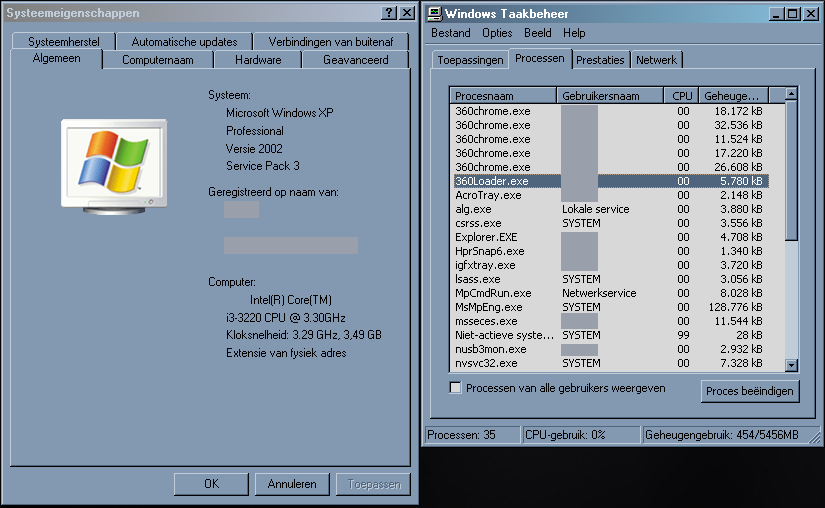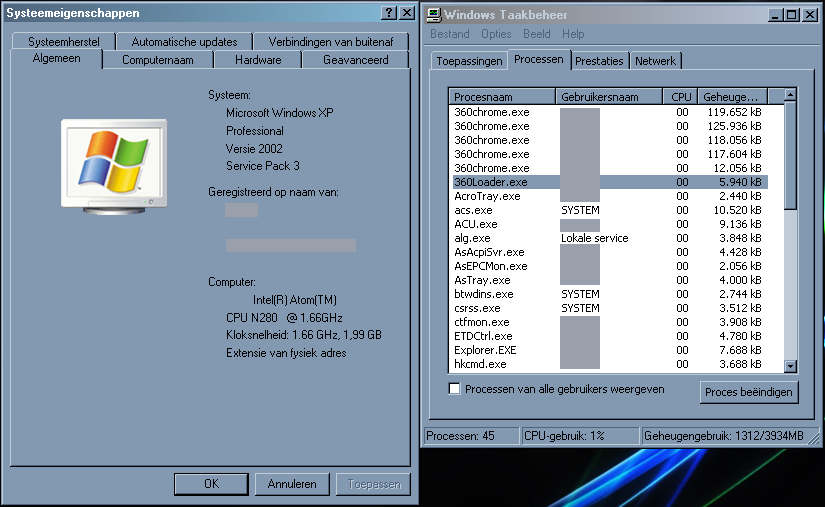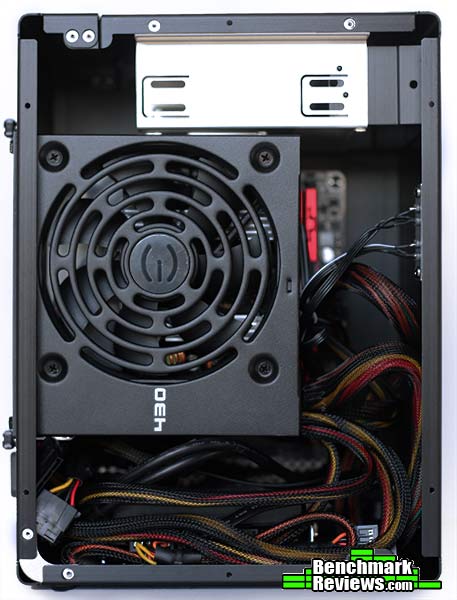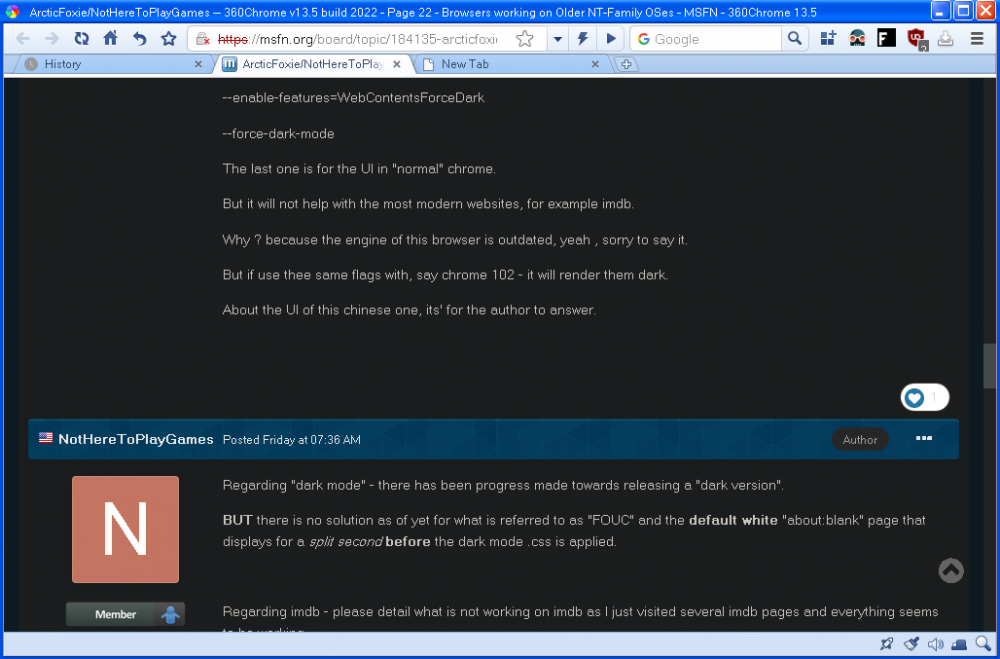
gerwin
MemberContent Type
Profiles
Forums
Events
Everything posted by gerwin
-
Thanks for the list. With software of that kind, combined with an older OS, and particular use cases, versions matter a lot. As for HqMame. I noticed some other versions gave stuttering audio on a Sandy bridge laptop. And from 2012 to 2016 executable size grew from 60MB to a whopping 120 MB.
-
Six months ago I was curious about some old arcade games. Which, as usual, got me tinkering with software without playing much I found it preferable to use the HqMAME fork, because it can smoothen the pixelation out nicely, and it does it internally to the sprites or layers for better effect. This one: HqMAME v2.2 based on MAME v0.147u3, dated 11-12-2012. Modded with HqMAME v2.16 scaler dlls, which seem to work fine. On Windows XP SP3 x86 that is.
-
In the linked post at vogons.org Falcosoft added screenshots to illustrate things. In that quoted bit, I am also wondering what Falcosoft meant with the term "PC resolution", I don't know...
-
Coincidentally, Falcosoft at vogons just posted a good summary of NVidia/WinXP custom resolution support. I already intended to append it here. QUOTED, from https://www.vogons.org/viewtopic.php?f=63&t=92849&p=1143505#p1143505 Falcosoft Posted on 25-2-2023 The last XP driver that has working GPU scaling option is 355.98. Also you should use VGA or DVI instead of HDMI. Important! Under XP do not use HDMI since: - You will not get scaling options. - You cannot set the dynamic range to Full RGB so you will always get limited RGB. This results in incorrect black levels in case of PC monitors. Important! In order to get these options you have to switch to a PC or non-native based resolution. After you selected the desired option it also applies to native based resolutions or non-PC resolutions. (The below examples show what is possible with DVI) 1. Use Nvidia scaling: In this case the display always stays in its native resolution but no aspect ratio correction is applied by the GPU so you will always get a full screen image. This case is trivial so I do not attach a screenshot. 2. Use Nvidia scaling with fixed aspect ratio: In this case the display always stays in its native resolution but the GPU also applies aspect ratio correction: Nvidia_aspect.jpg 3. Use my displays built-in scaling: In this case the display is switched for the given resolution and no aspect ratio adjustment is applied by the GPU. Your display has to correct aspect ratio either automatically or manually. 4. Do not scale: In this case the display always stays in its native resolution but the GPU not only corrects aspect ratio but draws a centered pixel perfect screen inside the native resolution (so in case of smaller resolutions you can get a tiny image) Also: https://www.vogons.org/viewtopic.php?p=899374#p899374
-
Oh look! This system is quite similar to the main i5-3550 above, also a GigaByte 6-series motherboard. Except it has an i3-3220 with 2 real cores and 2 HT. It has nVidia GT 710 graphics instead of AMD Radeon 7750. Now I just went into the BIOS and disabled the two HyperThreading cores. Run the test again: Taskmanager shows now 2 threads instead of 4, and the 360chrome memory allocation is quite the same (=low) so I did not bother to make a screen shot again.
-
I tested Chrome360 v13.5 on three systems with Windows XP x86 prof (PosReady), just the single empty startup tab: 1) Clean Chrome360 on an eee-PC 1000HE with intel Atom N280 single real core + HyperThreading core, 2GB RAM. 360chrome.exe shown 4x around 125MB allocated + 1x a smaller entry. See image. 2) Clean Chrome360 on a AMD E-350 APU nettop with 2 cores and no HT, 4GB RAM. 360chrome.exe shown 5x each around 125MB allocated. 3a) Clean Chrome360 on my main i5-3550 with 4 cores and no HT, 4GB RAM: 360chrome.exe shown 5x each around 125MB allocated. 3b) Slightly customized Chrome360 on my main i5-3550 with 4 cores and no HT, 4GB RAM: 360chrome.exe shown 5x around 125MB allocated + 1x a smaller entry.
-
Darn, I see that now. That is a big difference between one GT 730 and the other. GT 710, GK208 (28nm), 192 : 16 : 4, DDR3 on 64bit-bus, 19 W TDP GT 710, GK208 (28nm), 192 : 16 : 4, GDDR5 on 64bit-bus, 19 W TDP GT 730, GK208 (28nm), 384 : 16 : 8, DDR3 on 64bit-bus, 23 W TDP or 38 W ? GT 730, GK208 (28nm), 384 : 16 : 8, GDDR5 on 64bit-bus, 25 W TDP or 38 W ? GT 730, GF108 (40nm), 96 : 16 : 4, DDR3 on 128bit-bus, 49 W TDP GTX 950, GM206 (28nm), 768 : 48 :32, GDDR5 on 128bit-bus, 90 W TDP I compiled that list above, from different sources, because none of them show the complete lineup. https://en.wikipedia.org/wiki/GeForce_700_series https://www.techpowerup.com https://videocardz.net/nvidia-geforce-gt-730-gk208
-
From the name GT 730, one would expect it to offer more then a GT 710. But when I compare the data below (basic DDR3 models), I cannot find much in favor of the GT 730. It says it uses more watt, whilst performing about the same as GT 710, or slightly less. GT 730 core is on an older 40 nm process. https://www.techpowerup.com/gpu-specs/msi-gt-710-low-profile-2-gb.b4101 https://www.techpowerup.com/gpu-specs/gainward-gt-730.b3008 EDIT, I think the theoretical performance in the links above, does not properly consider the memory bandwidth difference, and find this more realistic: https://www.quora.com/Is-a-GT-710-2GB-DDR5-better-than-a-GT-730-2GB-DDR3?share=1 "The GT 730 is about 30% better than the GT 710" Where "better" is only meaning a higher frame-rate, I recon, because it is not better in the subject of features or power usage.
-
My Windows 95 on a 486 Vesa local bus system is still perfectly usable, for playing MP3s (at 22kHz max) and playing Freecell. I expect it to remain usable for such until the capacitors die of old age. Then I will recap it, making it usable for another 20 years. Just a silly remark, for the vague statement of 'usable'.
-
When I look at images of GTX 950 and 960, they do appear more like mid-range GPUs. Besides my main PC, I am working with two Lian Li PC-Q07B cases for Mini-ITX. They offer just one PCIe expansion slot at the bottom. Airflow is very limited there. Power supply can be ATX-size, but preferably the smaller SFX size. See attached example image, which is lacking a GPU there. Any GT 710 will work in that spot, but I don't see a match for a GTX 950/960. I tested this one "With v347.09 brief testing, I have seen one hang with 3Dmark2001SE. Showing a benchmark intro screen, about to fade in, but it remains very dark forever. Two other runs; no problem." So for a GT 710 on Windows XP I am a bit suspect about any driver v347.09 or later. I will have to check if my current v344.75 driver has the custom resolution support...
-
Thanks for explaining. I am not complaining, was just wondering for a moment. I almost never used chrome before, so I am just a rookie considering chrome's methods. And for the most part I can only solve that by trying and reading myself, and not wasting too much of your time. Of course there are technically good things about chrome, similar to how I expect there to be technically good things in Windows 10/11. (Even though the latter p***es me off in many other aspects.) This chrome install already succeeded in one scenario, where Newmoon 28 was failing recently with endless loops of cloudflare checks. So there it saves me a reboot into Linux. Much appreciated!
-
Yes. And as for new GT 710 cards, it seems retailers are phasing them out now. And I don't see another low-end card taking its place. There will always be loads of second hand of course, but you are right, it will be hard to find or identify GDDR5 ones. In my initial post is a reading of the effects of the PCIe v1.1 link width: at 1x link width: 24160 points 3DMark2001 at 8x link width: 30554 points 3DMark2001 So for that setup 1x link gives a noticeable performance decrease. Not that severe, but still a bit worrisome.
-
Thanks, indeed I initially used the "ungoogled" version. Thinking less google equals better? Now with the normal edition, I could easily add extensions and also added Draker's two parameters. Good te see all three extensions work. That is Dark Reader / change all UI fonts / uBlock origin. The program UI is still ugly luna/white, but that is just 10% of what I am looking at. MSFN forum looks very nice now, in my taste. Posting this from Chrome too. I notice in the task manager, 360chrome.exe is spawned six times, for a single tab. Then additional single entries spawn for each tab?
-
I intend to try this browser next to Newmoon28, to see if it manages some sites where Newmoon fails. But as usual the bright white chrome interface is not making it very pleasant for my eyes. Are there any working extensions to darken/recolor the UI and/or the page rendering? Of course there is Dark Reader on the web store, but I see no "Add to chrome" option, so I guess the chrome version is too outdated to install such the normal way.
-
A small update on this subject. I upgraded the Mini-ITX motherboard. Before it was an intel GM45 with Mobile Penryn CPU, now I switched to a GA-H67N-USB3-B3 board with Ivy Bridge CPU. Same Windows XP OS. The above quoted GT 710 PCIe lane idling issues are gone in the newer system. It works properly all the time now. So that is good news. I ran some benchmarks. Of course no stellar performance with such humble graphics hardware. But it is Mini-ITX, a very compact system. Gigabyte GA-H67N-USB3-B3 with intel Core i3-3220 @3,3 GHz (Except the underclock entry), 2x2GB RAM. NVidia Driver used: v344.75 3D Mark 2001 SE: MSI/NVidia GT 710, 1GB DDR3, CPU 1,6GHz underclock --- 26933 3D Marks MSI/NVidia GT 710, 1GB DDR3 --- 32440 3D Marks Gigabyte/NVidia GT710, 2GB GDDR5 --- 41096 3D Marks intel HD2500, driver 2013 --- 19849 3D Marks 3D Mark 2005: MSI/NVidia GT 710, 1GB DDR3 --- 13706 3D Marks Gigabyte/NVidia GT 710, 2GB GDDR5 --- 16899 3D Marks intel HD2500, driver 2013 --- 5779 3D Marks
-
That is not as easy as you may think. Maybe read the document here: https://msfn.org/board/topic/182311-windows-xp-on-intel-skylake-chipset-possible/
-
That is "Rar 5" format For example WinRar v5.91 opens it. 7-Zip v19.00 or current opens it.
-
I attached it here. As downloaded with Roytam Newmoon 28. palefill-1.22.xpi
-
Thanks for the link! .. I will keep it short as to not hijack this thread.
-
MinGW v10.3, that is cool. I thought v8.4.0 was the latest in Windows XP.
-
I tried the mouserate.exe tool: Windows XP x86 on Intel Z68 with i5-3550: about 300Hz max with "show" checked / around 4000 to 5000 Hz with it "show" unchecked. Windows 7 x64 on Intel Z68 with i5-3550: 125Hz max ** Windows XP x86 on Intel GM45/ICH9M with Core 2 duo: 125Hz max ** Windows XP x86 on AMD E-350 Nettop: 125Hz max ** ** = Both with and without "show" checkbox. But I have no practical issues with the Windows XP x86 on Intel Z68. Not that I know of. All loads and temperatures are in check. 3Dmark 2005 scores the exact same on both Win XP vs Win 7.
-
Yeah. Bummer. At the time, these Atom systems seemed like compact and fun systems to toy around with.. But I figured Windows 7 would make it an annoyingly slow experience at times, so I never considered any Atom system again... Did toy around with an AMD E-350 nettop with Windows XP. Which is in the same class, but slightly more desirable: Much better 3D, but the CPU is almost as slow as the early Atoms.




